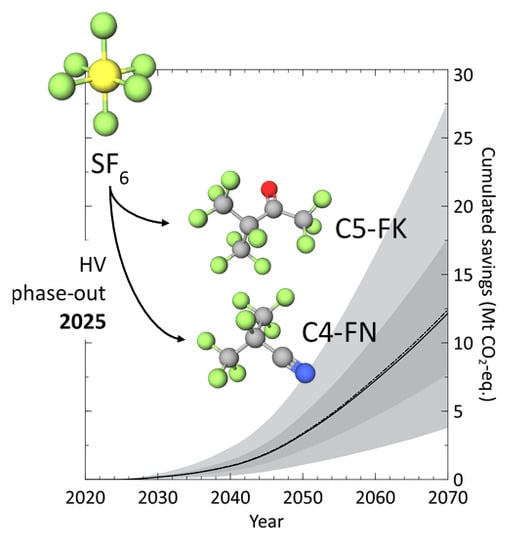Replacing SF6 in Electrical Gas-Insulated Switchgear: Technological Alternatives and Potential Life Cycle Greenhouse Gas Savings in an EU-28 Perspective
Abstract
1. Introduction
2. Materials and Methods
2.1. Single High-Voltage Bay Comparative Lifecycle Carbon Footprint Assessment
2.2. Estimation of EU-28-Wide Installed Amount of SF6 Gas in Gas-Insulated Switchgear Equipment
2.3. Consequential Time-Series Modeling of Greenhouse Gas Savings in Phase-Out Scenarios
2.4. Uncertainty Analysis
3. Results
3.1. Single 145 kV GIS Bay Comparative Carbon Footprint Assessment
3.2. Cumulative Greenhouse Gas Savings in the EU-28 (HV) Transmission Grid in SF6 Phase-Out Scenarios
4. Discussion
5. Conclusions
Supplementary Materials
Author Contributions
Funding
Acknowledgments
Conflicts of Interest
References
- Kieffel, Y.; Biquez, F. SF6 alternative development for high voltage switchgears. In Proceedings of the 33rd Electrical Insulation Conference (EIC 2015), Seattle, WA, USA, 7–10 June 2015; pp. 379–383. [Google Scholar] [CrossRef]
- Xiao, S.; Zhang, X.; Tang, J.; Liu, S. A review on SF6 substitute gases and research status of CF3I gases. Energy Rep. 2018, 4, 486–496. [Google Scholar] [CrossRef]
- Mhyre, G.; Shindell, D.; Bréon, F.-M.; Collins, W.; Fuglestvedt, J.; Huang, J.; Zhang, H. Anthropogenic and Natural Radiative Forcing. In Climate Change 2013: The Physical Science Basis. Contribution of Working Group I to the Fifth Assessment Report of the Intergovernmental Panel on Climate Change; Stocker, T.F., Qin, D., Plattner, G.-K., Tignor, M.S., Allen, K., Boshung, J., Midgley, P.M., Eds.; Cambridge University Press: Cambridge, UK; New York, NY, USA, 2013; pp. 659–740. [Google Scholar] [CrossRef]
- European Parliament and Council of the European Union. Regulation (EC) No 842/2006 of the European Parliament and of the Council of 17 May 2006 on certain fluorinated greenhouse gases. Off. J. Eur. Union 2006, L161, 1–11. [Google Scholar]
- European Parliament and Council of the European Union. Regulation (EU) No 517/2014 of the European Parliament and of the Council of 16 April 2014 on fluorinated greenhouse gases and repealing Regulation (EC) No 842/2006. Off. J. Eur. Union 2014, 57, 195–230. [Google Scholar]
- UNFCCC National Inventory Submissions 2019. Available online: https://unfccc.int/process-and-meetings/transparency-and-reporting/reporting-and-review-under-the-convention/greenhouse-gas-inventories-annex-i-parties/national-inventory-submissions-2019 (accessed on 10 November 2019).
- Preisegger, E.; Durschner, R.; Klotz, W.; Konig, C.-A.; Krahling, H.; Neumann, C.; Pittroff, M.; Zahn, B. Life cycle assessment-electricity supply using SF6 technology. In Proceedings of the 2001 International Symposium on Electrical Insulating Materials (ISEIM 2001), 2001 Asian Conference on Electrical Insulating Diagnosis (ACEID 2001), 33rd Symposium on Electrical and Electronic Insulating Materials and Applications in System, Hemeij, Japan, 22 November 2001; pp. 371–374. [Google Scholar]
- ABB Gas-Insulated Compact Switchgear SafePlus Air. Available online: https://new.abb.com/medium-voltage/switchgear/gas-insulated-switchgear/iec-gis-rmu-for-secondary-distribution/iec-gas-insulated-compact-switchgear-safeplus-air (accessed on 7 November 2019).
- Burgers, K.; Doring, M.; Hussy, C.; Rhiemeier, J.-M.; Franck, C.; Rabie, M. Concept for SF6-Free Transmission and Distribution of Electrical Energy, Ecofys Report 03KE0017. 2018. Available online: https://www.umweltbundesamt.de/sites/default/files/medien/2503/dokumente/final-report-sf6_en.pdf (accessed on 3 November 2019).
- DRIESCHER Medium Voltage Switchgear ECOS-C 2017. Available online: https://www.driescher.de/wp-content/uploads/2018/08/ECOS-C_eng.pdf (accessed on 3 November 2019).
- Eaton. Xiria E Uitbreidbaar Schakelsysteem Voor Onderverdeelstations En Commerciële & Industriële Toepassingen. 2014. Available online: http://www.eaton.be/fr/ecm/idcplg?idcservice=get_file&allowinterrupt=1&revisionselectionmethod=latestreleased&nosaveas=0&rendition=primary&ddocname=pct_495078 (accessed on 15 October 2019).
- Schneider 2017 Catalog: Premset 17.5 kV Compact Modular Vacuum Switchgear with Shielded Solid Insulation System. 2016. Available online: https://download.schneider-electric.com/files?p_enDocType=Catalog&p_File_Name=Premset_CAT_AMTED310010EN_012017.pdf&p_Doc_Ref=AMTED310010EN (accessed on 15 November 2019).
- Siemens Gas-Insulated Medium-Voltage Switchgear 8DJH 12—Blue GIS. 2019. Available online: https://new.siemens.com/global/en/products/energy/medium-voltage/systems/8djh12.html (accessed on 7 November 2019).
- Siemens 8VN1 Blue GIS up to 145 kV—Vacuum Interrupting Technology and Clean Air Insulation for CO2-Neutral Footprint. 2018. Available online: https://assets.new.siemens.com/siemens/assets/public.1541966714.1f338d6d66d6c97e73cdd979ad1cd5f1d9acaefd.emhp-b10016-01-7600-8vn1-blue-gis.pdf (accessed on 15 October 2019).
- ABB AirPlusTM Enhancing Eco-Efficiency Alternative to SF6 for High- and Medium-Voltage Products. 2019. Available online: https://library.e.abb.com/public/1d46c9d1a34f4610aab195aebabb38d0/airplus_flyer_info_1hc0136414ab_en.pdf (accessed on 10 November 2019).
- ABB Environmental Product Declaration—GIS Type ELK-14 for 300 kV. 2019. Available online: https://library.e.abb.com/public/2f13e1b6c5196727c125716800439ef7/EPDELK-14300kVAC-English.pdf (accessed on 14 November 2019).
- ABB—IEC gas insulated switchgear ZX2 AirPlus, 2019d. Available online: https://new.abb.com/medium-voltage/switchgear/gas-insulated-switchgear/iec-gis-primar-distribution/iec-gas-insulated-primary-switchgear-zx2-airplus (accessed on 7 November 2019).
- Bünger, S. Isoliergasmischung und damit befüllte Schaltanlage. Patent DE 10,2017,105,982,A1, 27 September 2018. [Google Scholar]
- General Electric—F35 Gas-Insulated Substations 145 kV, 40 kA, 3 150 A. 2016. Available online: https://www.gegridsolutions.com/products/brochures/Grid-GIS-L3-F35_145_kV-0169-2016_07-EN.pdf (accessed on 25 October 2019).
- Noda, K.; Aoyama, H. Process for the Preparation of Perfluoroalkanones. U.S. Patent 2003,014,455,7A1, 31 July 2003. [Google Scholar]
- Phillip, M.E.; Milian, A.S. Method of Making Fluorinated Carbonyl Compounds. U.S. Patent 3,321,515A, 23 May 1963. [Google Scholar]
- Li, X.; Zhao, H.; Murphy, A.B. SF6-alternative gases for application in gas-insulated switchgear. J. Phys. D Appl. Phys. 2018, 51, 153001. [Google Scholar] [CrossRef]
- Koch, M.; Franck, C.M. High voltage insulation properties of HFO1234ze. IEEE Trans. Dielectr. Electr. Insul. 2015, 22, 3260–3268. [Google Scholar] [CrossRef]
- Preve, C.; Piccoz, D.; Maladen, R. Application of HFO1234ZEE in MV switchgear AS SF6 alternative gas. CIRED Open Access Proc. J. 2017, 1, 42–45. [Google Scholar] [CrossRef]
- Eves, M.; Kilpatrick, D.; Edwards, P.; Beryy, J. SF6 Alternatives—A Literature Review on SF6 Gas Alternatives for Use on the Distribution Network. Western Power Distribution report SF6 Alternatives. 2018. Available online: https://www.westernpower.co.uk/downloads/5857 (accessed on 25 October 2019).
- General Electric Green Gas for Grid—g3 Roadmap 2025. 2019. Available online: https://www.gegridsolutions.com/app/Resources.aspx?prod=g3&type=5 (accessed on 8 November 2019).
- ABB Wins $40 Million Order for Eco-Efficient Substation in Germany. Available online: https://new.abb.com/news/detail/9877/abb-wins-40-million-order-for-eco-efficient-substation-in-germany (accessed on 8 November 2019).
- Siemens to Retrofit One of the Largest Substations in Germany (Press Release). Available online: https://press.siemens.com/global/en/pressrelease/siemens-retrofit-one-largest-substations-germany (accessed on 16 December 2019).
- EcoTransparency for More Environmentally Friendly Energy|Energy Products Lamp; Services|Siemens. Available online: https://new.siemens.com/global/en/products/energy/ecotransparency.html (accessed on 7 November 2019).
- ABB Launches Its Groundbreaking Eco-Efficient AirPlusTM Switchgear in China. Available online: http://www.abb.com/cawp/seitp202/cafeb7e5a446d843c12581c600203b7d.aspx (accessed on 8 November 2019).
- ABB’s Eco-Efficient AirPlusTM Technology Delivered to Norwegian Smart Grid. Available online: https://new.abb.com/news/detail/6392/abbs-eco-efficient-airplus-technology-delivered-to-norwegian-smart-grid (accessed on 8 November 2019).
- T&D Europe. Technical Report on Alternative to SF6 Gas in Medium Voltage & High Voltage Electrical Equipment; T&D Europe Aisbl: Brussels, Belgium, 2018; 56p. [Google Scholar]
- CO2 Equivalent Calculator General Electric. Available online: https://www.gegridsolutions.com/productexplorers/greengas/default.aspx?utm_source=gswebsite&utm_medium=resources&utm_campaign=g3-explorer#/ (accessed on 12 November 2019).
- Gautschi, D.; Ficheux, A.; Walter, M.; Vuachet, J. Application of a fluoronitrile gas in GIS and GIL as an environmental friendly alternative to SF6. CIGRE 2016, B3-106, 1–11. [Google Scholar]
- Kieffel, Y.; Biquez, F.; Vigouroux, D.; Ponchon, P.; Schlernitzauer, A.; Magous, R.; Cros, G.; Owens, J.G. Characteristics of g3—An alternative to SF6. In Proceedings of the 24th International Conference & Exhibition on Electricity Distribution (CIRED), Glasgow, UK, 12–15 June 2017. [Google Scholar] [CrossRef]
- Stoller, P.C.; Doiron, C.B.; Tehlar, D.; Simka, P.; Nanjan, N. Mixtures of CO2 and C5F10O perfluoroketone for high voltage applications. IEEE Trans. Dielectr. Electr. Insul. 2017, 24, 2712–2721. [Google Scholar] [CrossRef]
- 3MTM NovecTM 5110 Insulating Gas. Available online: http://multimedia.3m.com/mws/media/1132123O/3m-novec-5110-insulating-gas.pdf (accessed on 16 November 2019).
- Althaus, H.; Chudacoff, M.; Hischier, R.; Jungbluth, N.; Osses, M.; Primas, A. Life Cycle Inventories of Chemicals; Ecoinvent Report No. 8, v2.0; EMPA Dübendorf, Swiss Center for Life Cycle Inventories: Dübendorf, Switzerland, 2017. [Google Scholar]
- Glaubitz, P.; Stangherling, S.; Crawley, D.; Henriot, J.; Holm, A.; Jannick, P.; Justiz, P.; Mehuro, M.; Probst, R.; Sieber, P.; et al. Guide for the Preparation of Custimised “Practical SF6 Handling Instructions”; Cigre TF B3.02.01 276; CIGRE: Paris, France, 2005. [Google Scholar]
- Glaubitz, P.; Plöger, F. Obtaining Low SF6 Emissions in Germany. In Proceedings of the 4th International Conference on SF6 and the Environment, San Antonio, TX, USA, 28–30 November 2006. [Google Scholar]
- ABB Product Brochure—Gas-Insulated Switchgear ELK-04 C, 145 kV. Available online: https://library.e.abb.com/public/a58460fee6384fa8a31802fb836d3372/ELK-04_C_145_2GHV008915_0315En.pdf (accessed on 14 November 2019).
- ABB Special Report—High-Voltage Products. Available online: https://library.e.abb.com/public/a35ad08543a74b39c1257b35003b77ef/ABBSRHVProducts_72dpi.pdf (accessed on 14 November 2019).
- General Electric. Gas Insulated Switchgear 72.5–800 kV—Advanced Technology in a Modular, Flexible, and Compact Desing. Brochure Grid-GIS-L3-F35_145_kV-0169-2016_07-EN. 2013. Available online: http://www.gegridsolutions.com/products/brochures/PrimaryEquip/GIS_Family.pdf (accessed on 14 November 2019).
- Siemens. Gas-Insulated Switchgear from 72.5 to 550 kV. 2016. Available online: https://assets.new.siemens.com/siemens/assets/public.0.c436b02a315b9459febb5797cd219bebe81ff348.emhp-b10009-00-7600-gis-en-160205-1-ansicht.pdf (accessed on 14 November 2019).
- Glaubitz, P.; Wallner, C. Gas-Insulated-Substations SF6 Gas Handling. In Proceedings of the EPA 2012 Workshop on SF 6-Emission Reduction Strategies, Atlanta, GA, USA, 17–18 April 2012. [Google Scholar]
- Bessede, J.L.; Huet, I.; Barbier, E.; Micozzi, J. Implementation Of Treatment & Recovery Of the SF6 Gas Containing A High Amount of Decomposition Products Due To High Voltage Electrical Interruptions. Scottsdale, AZ, USA, 1–3 December 2004. Available online: www.epa.gov/highgwp/electricpower-sf6/pdf/dec04/montillet_barbier.pdf (accessed on 25 October 2019).
- Solvay. The SF6-ReUse-Process: A Contribution on the Sustainability of SF6. Available online: https://www.solvay.com/sites/g/files/srpend221/files/tridion/documents/SF6-ReUse-Process.pdf (accessed on 16 November 2019).
- Owens, J.G. Greenhouse Gas Emission Reductions through use of a Sustainable Alternative to SF 6. In Proceedings of the IEEE Electrical Insulation Conference (EIC), Montreal, Canada, 19–22 June 2016; pp. 535–538. [Google Scholar] [CrossRef]
- Ren, Y.; Bernard, F.; Daële, V.; Mellouki, A. Atmomspheric fate and impact of perfluorinated butanone and pentanone. Environ. Sci. Technol. 2019, 53, 8862–8871. [Google Scholar] [CrossRef] [PubMed]
- Taniguchi, N.; Wallington, T.J.; Hurley, M.D.; Guschin, A.G.; Molina, L.T.; Molina, M.J. Atmospheric chemistry of C2F5C(O)CF(CF3)2: Photolysis and reaction with Cl atoms, OH radicals, and ozone. J. Phys. Chem. A 2003, 107, 2674–2679. [Google Scholar] [CrossRef]
- Plöger, F.; Schwarz, W.; Thesen, S.; Preisegger, E.; Ajavon, A.-L.N.; Zhou, D. Chapter 8: Other product manufacture and use. In 2006 IPCC Guidelines for National Greenhouse Gas Inventories, Prepared by the National Greenhouse Gas Inventories Programme; Eggleston, H.S., Buendia, L., Miwa, K., Ngara, T., Tanabe, K., Eds.; IGES: Kanagawa, Japan, 2006. [Google Scholar]
- UNFCCC. Report of the Conference of the Parties on Its Nineteenth Session FCCC/CP/2013/10. In Proceedings of the the Conference of the Parties on Its Nineteenth Session FCCC/CP/2013/10, Warsaw, Poland, 11–23 November 2013. [Google Scholar]
- Eurostat—Electricity and Heat Statistics—Statistics Explained. Available online: https://ec.europa.eu/eurostat/statistics-explained/index.php/Electricity_and_heat_statistics#Installed_electrical_capacity (accessed on 11 November 2019).
- EDGAR. Global Emissions EDGAR v4.2 FT2010. 2013. Available online: https://edgar.jrc.ec.europa.eu/overview.php?v=42FT2010 (accessed on 10 November 2019).
- Rabie, M.; Franck, C.M. Assessment of eco-friendly gases for electrical insulation to replace the most potent industrial greenhouse gas SF6. Environ. Sci. Technol. 2018, 52, 369–380. [Google Scholar] [CrossRef] [PubMed]
- Rigby, M.; Mühle, J.; Miller, B.R.; Prinn, R.G.; Krummel, P.B.; Steele, L.P.; Elkins, J.W. History of atmospheric SF6 from 1973 to 2008. Atmos. Chem. Phys. 2010, 10, 10305–10320. [Google Scholar] [CrossRef]
- O’doherty, S.; Stanley, K.; Rigby, M.; Stavert, A. Report to BEIS: Long-Term Atmospheric Measurement and Interpretation (of Radiatively Active Trace Gases); Annual Report (sept 2017–sept 2018); BEIS Contract No. GA0201; Met Office: Exeter, UK, 2018. [Google Scholar]
- MIT. AGAGE: Advanced Global Atmospheric Gases Experiment. Available online: https://agage.mit.edu/about/ (accessed on 11 November 2019).
- Prinn, R.G.; Weiss, R.F.; Fraser, P.J.; Simmonds, P.G.; Cunnold, D.M.; Alyea, F.N.; Wang, R.H.J. A history of chemically and radiatively important gases in air deduced from ALE/GAGE/AGAGE. J. Geophys. Res. 2000, 105, 17751–17792. [Google Scholar] [CrossRef]
- Prinn, R.G.; Weiss, R.F.; Arduini, J.; Arnold, T.; Fraser, P.J.; Ganesan, A.L.; Gasore, J.; Harth, C.M.; Hermansen, O.; Kim, J.; et al. The ALE/GAGE/AGAGE Data Base. Available online: http://agage.mit.edu/data (accessed on 20 September 2019).
- Prinn, R.G.; Weiss, R.F.; Arduini, J.; Arnold, T.; Langley Dewitt, H.; Fraser, P.J.; Zhou, L. History of chemically and radiatively important atmospheric gases from the Advanced Global Atmospheric Gases Experiment (AGAGE). Earth Syst. Sci. Data 2018, 10, 985–1018. [Google Scholar] [CrossRef]
- Leip, A.; Skiba, U.; Vermeulen, A.; Thompson, R.L. A complete rethink is needed on how greenhouse gas emissions are quantified for national reporting. Atmos. Environ. 2018, 174, 237–240. [Google Scholar] [CrossRef]
- Levin, I.; Naegler, T.; Heinz, R.; Osusko, D.; Cuevas, E.; Engel, A.; Ilmberger, J.; Langenfelds, R.L.; Neininger, B.; Rohden, C.; et al. The global SF6 source inferred from long-term high precision atmospheric measurements and its comparison with emission inventories. Atmos. Chem. Phys. 2010, 10, 2655–2662. [Google Scholar] [CrossRef]
- Weiss, R.F.; Levin, I.; Meijer, Y.J. Atmospheric Monitoring and Inverse Modelling for Verification of Greenhouse Gas Inventories Tracking Biosphere C Emissions with Radiocarbon Measurements in Northern Wisconsin View Project Modelling and Informing Low-Emission Strategies View Project; Publications Office of the European Union: Rue Mercier, Luxembourg, 2018. [Google Scholar] [CrossRef]
- Weiss, R.F.; Prinn, R.G. Quantifying greenhouse-gas emissions from atmospheric measurements: A critical reality check for climate legislation. Philos. Trans. R. Soc. Lond. Ser. A 2011, 369, 1925–1942. [Google Scholar] [CrossRef]
- EU Commission, DG Energy, Unit A4. Energy Statistical Datasheets for the EU Countries. 2011. Available online: http://data.europa.eu/euodp/data/dataset/information-on-energy-markets-in-eu-countries-with-national-energy-profiles/resource/24184068-8ec3-470a-ba28-5ca2317c6f6f (accessed on 13 November 2019).
- RED Electrica Corporate Resbonsibility Report. 2016. Available online: https://www.ree.es/sites/default/files/downloadable/ree_corporate_responsibility_report_2016_v2.pdf (accessed on 10 November 2019).
- RED Electrica REE Environmental Report. 2010. Available online: https://www.ree.es/sites/default/files/downloadable/ree-memoria-ma-2010-ing.pdf (accessed on 10 November 2019).
- RED Electrica, EMAS Environmental Statement. 2014. Available online: https://www.ree.es/sites/default/files/downloadable/declaracion_ambiental_emas_2014_eng.pdf (accessed on 10 November 2019).
- RED Electrica, EMAS Environmental Statement. 2018. Available online: https://www.ree.es/sites/default/files/downloadable/emas_environmental_statement_2018.pdf (accessed on 10 November 2019).
- Terna—Sustainability Report 2010. Available online: http://ternacsr2010.message-asp.com/en (accessed on 10 November 2019).
- Terna Sustainability Report. 2013. Available online: http://terna2013csr.rep.message-asp.com/sites/terna2013csr/files/download/en/2013_sustainability_report_en.pdf (accessed on 10 November 2019).
- Terna Sustainability Report. 2015. Available online: https://www.terna-reports.it/2016/assets/pdf/Terna_Sustainability_Report_2015.pdf (accessed on 10 November 2019).
- Terna Sustainability Report 2018. Available online: https://download.terna.it/terna/0000/1231/72.PDF (accessed on 10 November 2019).
- RTE Rapport d’activité 2007. Available online: http://clients.rte-france.com/htm/fr/mediatheque/telecharge/rapport_2007/RTE_RAnnu_2007.pdf (accessed on 10 November 2019).
- RTE Rapport De Développement Durable 2010. Available online: https://www.rte-france.com/sites/default/files/ra_rte_2010_rdd.pdf (accessed on 10 November 2019).
- RTE Activity and Sustainable Development Report 2012. Available online: https://www.rte-france.com/sites/default/files/ra_rte_2012_ra_uk.pdf (accessed on 10 November 2019).
- RTE Activity and Sustainable Development Report 2014. Available online: https://www.rte-france.com/sites/default/files/rte_rapportannuel2014_gb_bat.pdf (accessed on 10 November 2019).
- Ofgem RIIO-ED1 Electricity Distribution Annual Report 2015-16. Available online: https://www.ofgem.gov.uk/publications-and-updates/riio-electricity-distribution-annual-report-2015-16 (accessed on 10 November 2019).
- Ofgem RIIO-ED1 Electricity Distribution Annual Report 2016–2017. Available online: https://www.ofgem.gov.uk/publications-and-updates/riio-electricity-distribution-annual-report-2017-18 (accessed on 10 November 2019).
- Zhou, S.; Teng, F.; Tong, Q. Mitigating Sulfur Hexafluoride (SF6) Emission from Electrical Equipment in China. Sustainability 2018, 10, 2402. [Google Scholar] [CrossRef]
- Carpos, P.; De Vita, A.; Tasios, N.; Siskos, P.; Kannavou, M.; Preopoulos, A. Energy, transport and GHG emissions—Trends to 2050. In EU Reference Scenario; Publications Office of the European Union: Rue Mercier, Luxembourg, 2016. [Google Scholar] [CrossRef]
- Latin Hypercube vs. Monte Carlo Sampling. Available online: https://lumina.com/latin-hypercube-vs-monte-carlo-sampling/ (accessed on 5 December 2019).
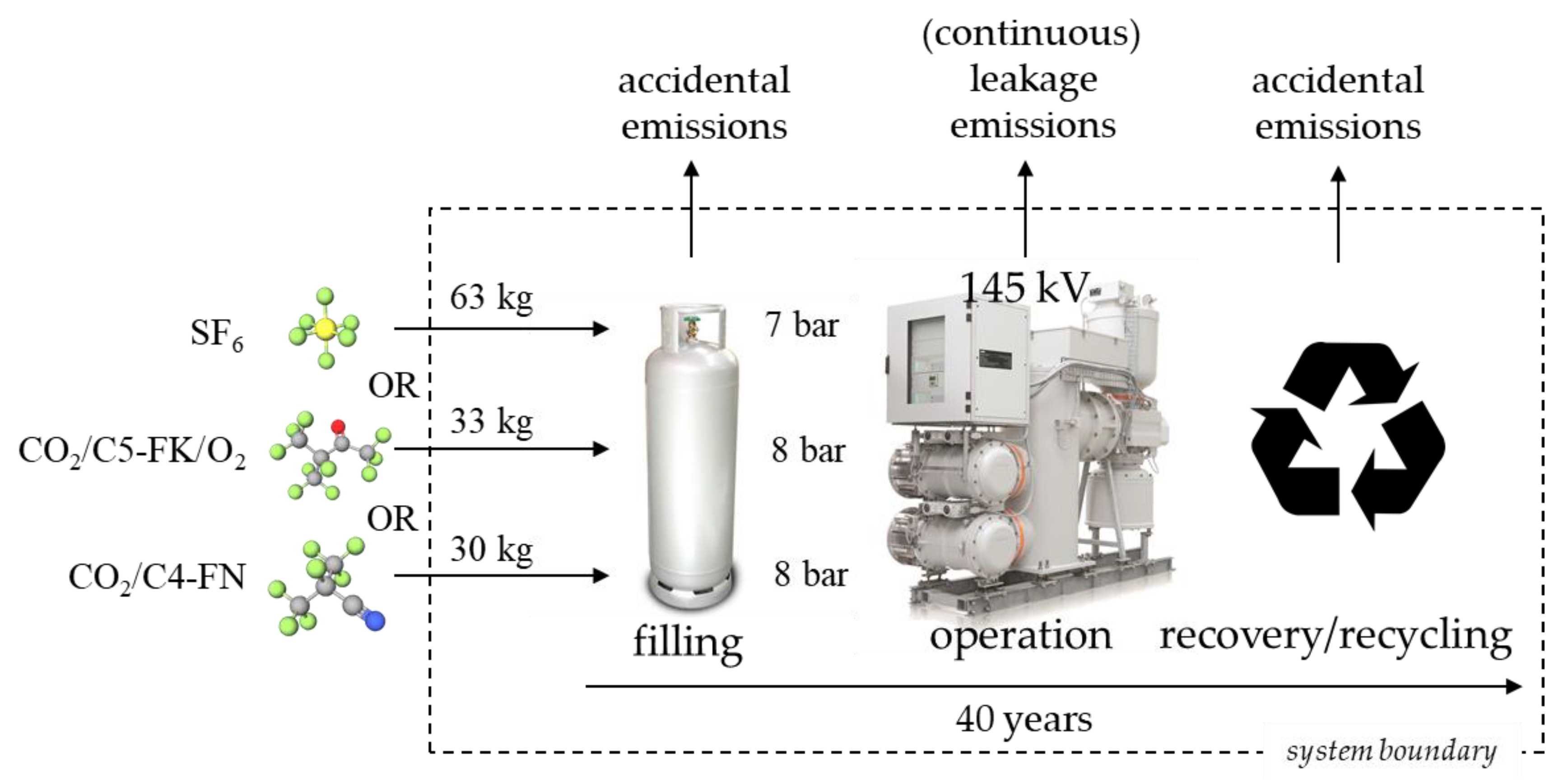
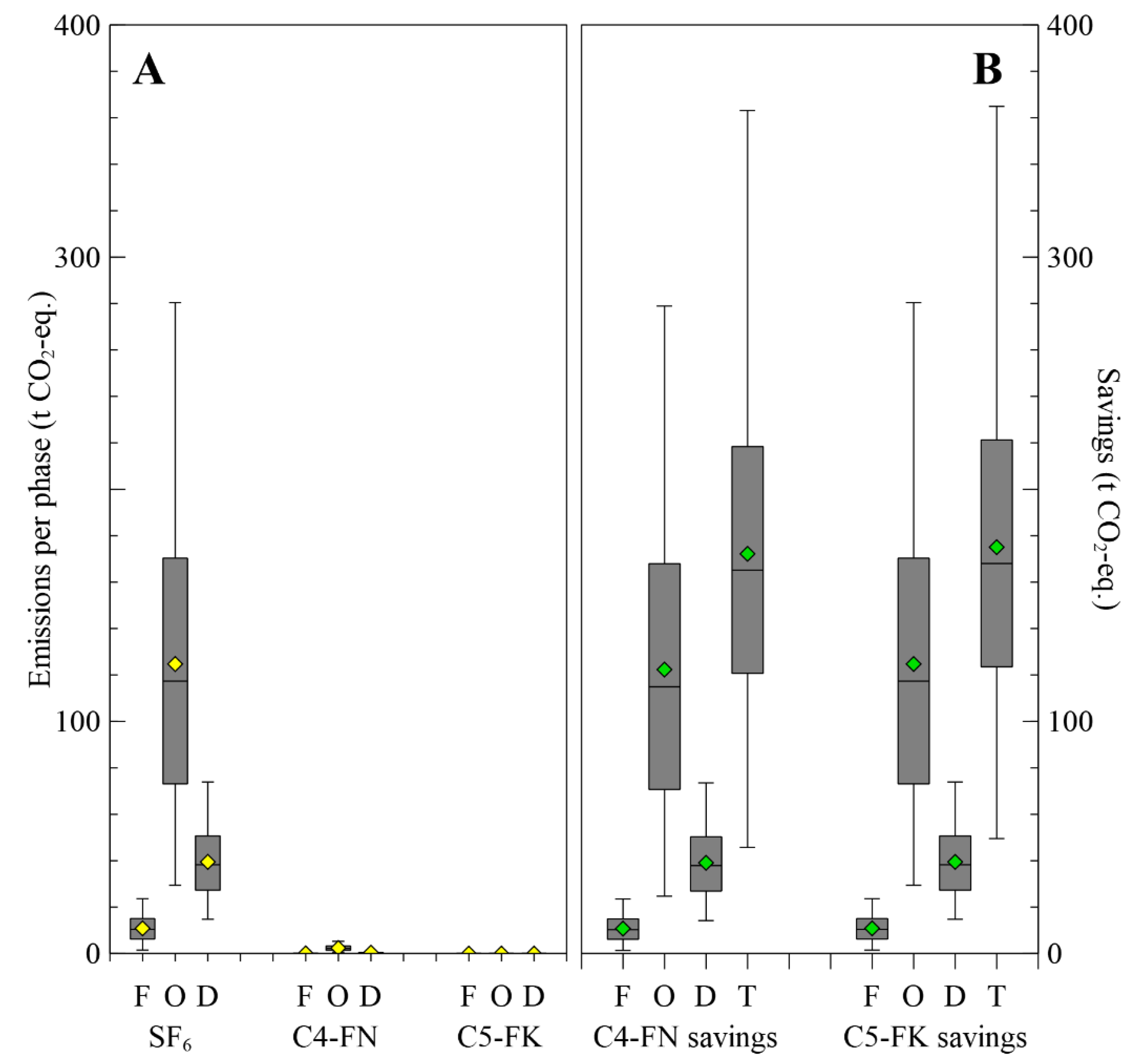
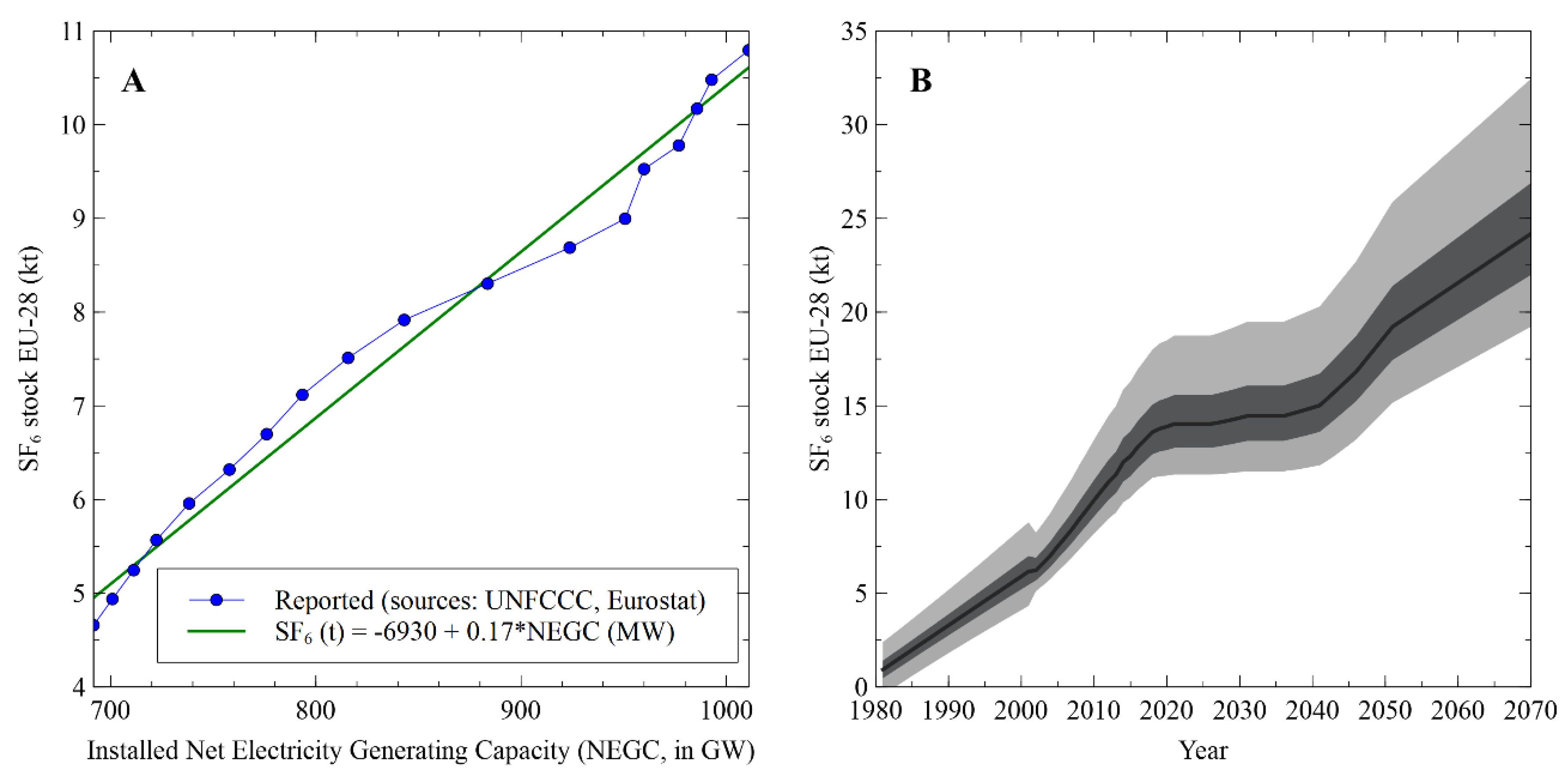
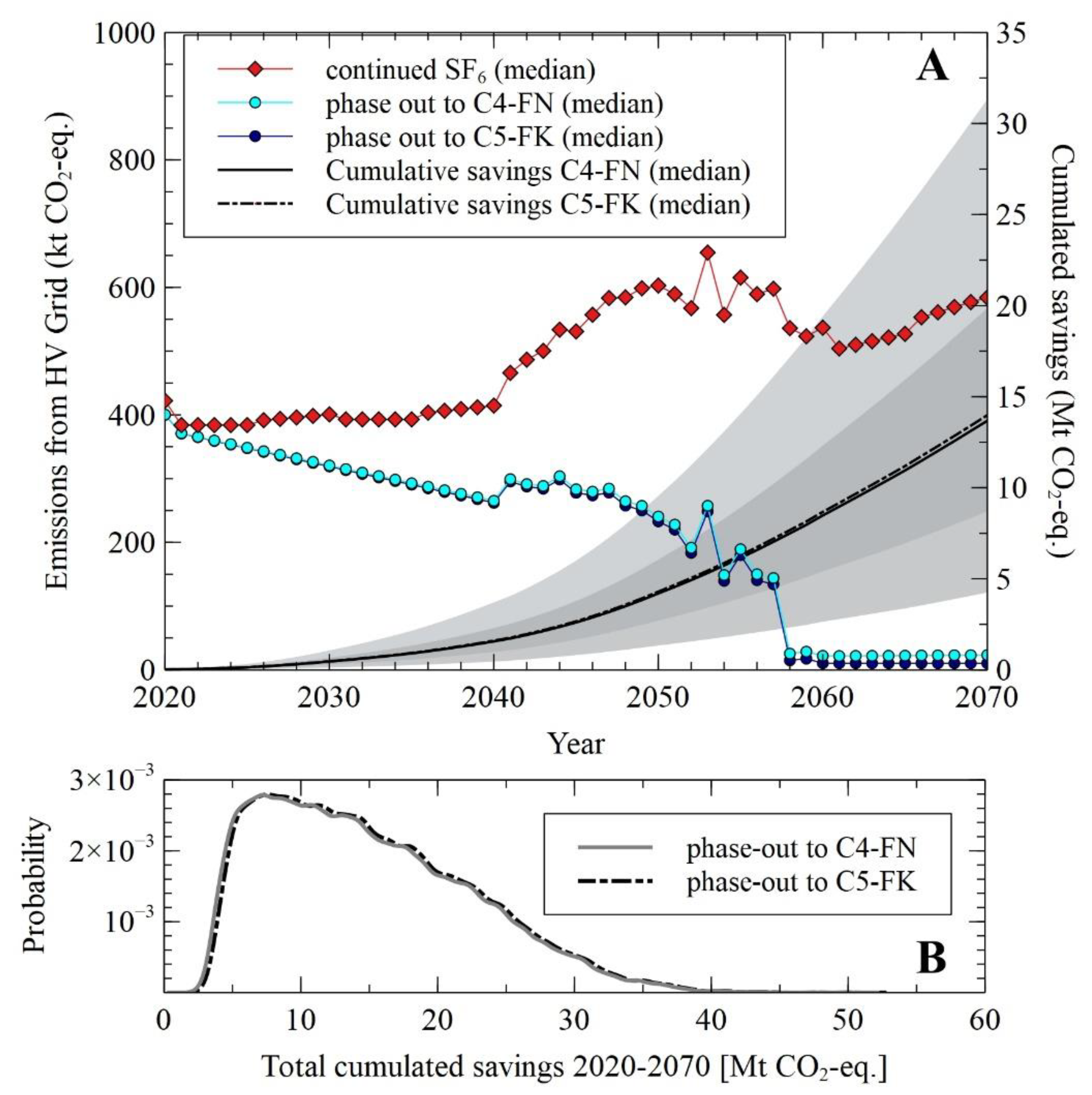
| Sulfur Hexafluoride (SF6) | Decafluoro-2-Methylbutan-3-one | Heptafluoro-2-Methylpropanenitrile |
|---|---|---|
| C5-FK | C4-FN | |
 | 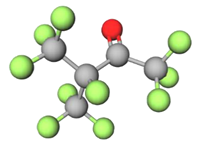 | 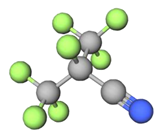 |
| Typical concentrations used in gas-insulated switchgear | ||
| 100% | 5.6 mole% C5-FK, 5.6 mole% O2, 88.8 mole% CO2 | 6 mole% C4-FN, 94 mole% CO2 |
| Parameter | Uncertainty Background | PDF Type | Description |
|---|---|---|---|
| EF filling [16,39,40] | Variety across sources | Modified PERT (γ = 1) | SF6: 0.1%, 0.5%, 1.6% |
| Alt (a): 0.1%, 0.5%, 1.6% | |||
| EF operation (leaks) [5,16,41,42,43,44] | Variety across sources | Modified PERT (γ = 1) | SF6: 0.05%, 0.1%, 0.5% |
| Alt (a): 0.1%, 0.2 %, 1% | |||
| EF recovery/recycling [6,16,40] | Variety across sources | Modified PERT (γ = 1) | SF6: 1%, 2%, 5% |
| Alt (a): 1%, 2%, 5% | |||
| EU-28 total SF6 stock in GISs | UNFCCC vs. EDGAR data | PERT negatively skewed | Min = 10800, mode = 12,700, max = 24,700 |
| Share of HV SF6 stock | MV stock uncertainty | Modified PERT (γ = 1) | 38.5%, 45%, 87.3% |
| Intercept regression SF6/IC (b) | Regression | Normal | µ = −6930 σ = 7 % |
| Parameter coefficient regression SF6/IC (b) | Regression | Normal | µ = 0.017 σ = 3.2 % |
© 2020 by the authors. Licensee MDPI, Basel, Switzerland. This article is an open access article distributed under the terms and conditions of the Creative Commons Attribution (CC BY) license (http://creativecommons.org/licenses/by/4.0/).
Share and Cite
Billen, P.; Maes, B.; Larrain, M.; Braet, J. Replacing SF6 in Electrical Gas-Insulated Switchgear: Technological Alternatives and Potential Life Cycle Greenhouse Gas Savings in an EU-28 Perspective. Energies 2020, 13, 1807. https://doi.org/10.3390/en13071807
Billen P, Maes B, Larrain M, Braet J. Replacing SF6 in Electrical Gas-Insulated Switchgear: Technological Alternatives and Potential Life Cycle Greenhouse Gas Savings in an EU-28 Perspective. Energies. 2020; 13(7):1807. https://doi.org/10.3390/en13071807
Chicago/Turabian StyleBillen, Pieter, Ben Maes, Macarena Larrain, and Johan Braet. 2020. "Replacing SF6 in Electrical Gas-Insulated Switchgear: Technological Alternatives and Potential Life Cycle Greenhouse Gas Savings in an EU-28 Perspective" Energies 13, no. 7: 1807. https://doi.org/10.3390/en13071807
APA StyleBillen, P., Maes, B., Larrain, M., & Braet, J. (2020). Replacing SF6 in Electrical Gas-Insulated Switchgear: Technological Alternatives and Potential Life Cycle Greenhouse Gas Savings in an EU-28 Perspective. Energies, 13(7), 1807. https://doi.org/10.3390/en13071807




